Apps
Auto Added by WPeMatico
Auto Added by WPeMatico
Want to run your own home shopping network? Facebook is now testing a Live video feature for merchants that lets them demo and describe their items for viewers. Customers can screenshot something they want to buy and use Messenger to send it to the seller, who can then request payment right through the chat app.
Facebook confirms the new shopping feature is currently in testing with a limited set of Pages in Thailand, which has been a testbed for shopping features. The option was first spotted by social media and reputation manager Jeff Higgins, and re-shared by Matt Navarra and Social Media Today. But now Facebook is confirming the test’s existence and providing additional details.
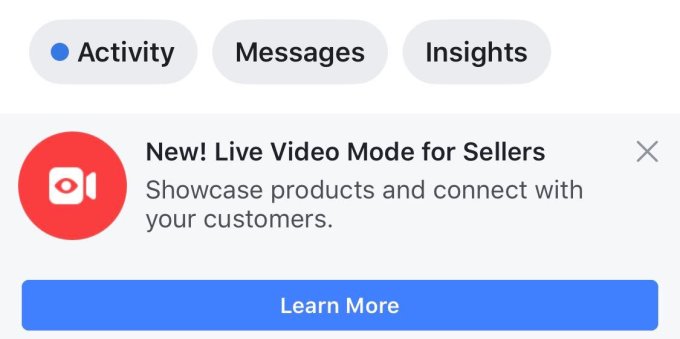
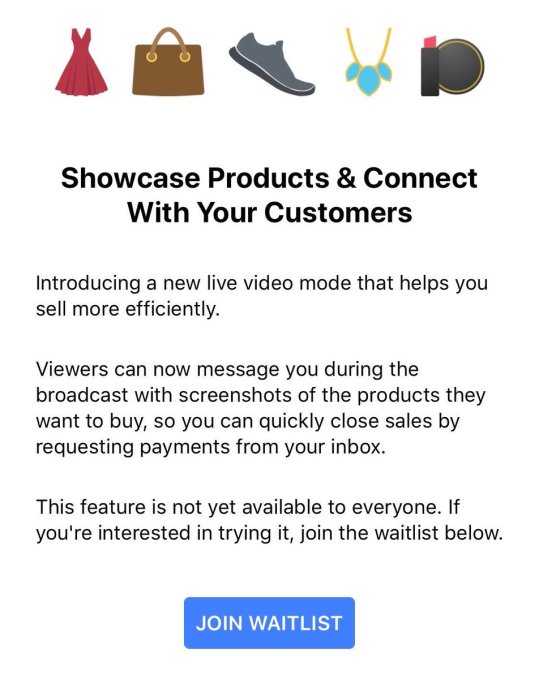 The company tells me it had heard feedback from the community in Thailand that Live video helped sellers demonstrate how items could be used or worn, and provided richer understanding than just using photos. Users also told Facebook that Live’s interactivity let customers instantly ask questions and get answers about product specifications and details. Facebook has looked to Thailand to test new commerce experiences like home rentals in Marketplace, as the country’s citizens were quick to prove how Facebook Groups could be used for peer-to-peer shopping. “Thailand is one of our most active Marketplace communities” says Mayank Yadav, Facebook product manager for Marketplace.
The company tells me it had heard feedback from the community in Thailand that Live video helped sellers demonstrate how items could be used or worn, and provided richer understanding than just using photos. Users also told Facebook that Live’s interactivity let customers instantly ask questions and get answers about product specifications and details. Facebook has looked to Thailand to test new commerce experiences like home rentals in Marketplace, as the country’s citizens were quick to prove how Facebook Groups could be used for peer-to-peer shopping. “Thailand is one of our most active Marketplace communities” says Mayank Yadav, Facebook product manager for Marketplace.
Now it’s running the Live shopping test, which allows Pages to notify fans that they’re broadcasting to “showcase products and connect with your customers.” Merchants can take reservations and request payments through Messenger. Facebook tells me it doesn’t currently have plans to add new partners or expand the feature. But some sellers without access are being invited to join a waitlist for the feature. It also says it’s working closely with its test partners to gather feedback and iterate on the live video shopping experience, which would seem to indicate it’s interested in opening the feature more widely if it performs well.
Facebook doesn’t take a cut of payments through Messenger, but the feature could still help earn the company money at a time when it’s seeking revenue streams beyond News Feed ads as it runs out of space there, Stories take over as the top media form and user growth plateaus. Hooking people on video viewing helps Facebook show lucrative video ads. The more that Facebook can train users to buy and sell things on its app, the better the conversion rates will be for businesses, and the more they’ll be willing to spend on ads. Facebook could also convince sellers who broadcast Live to buy its new Marketplace ad units to promote their wares. And Facebook is happy to snatch any use case from the rest of the internet, whether it’s long-form video viewing or job applications or shopping to boost time on site and subsequent ad views.
Increasingly, Facebook is setting its sights on Craigslist, Etsy and eBay. Those commerce platforms have failed to keep up with new technologies like video and lack the trust generated by Facebook’s real-name policy and social graph. A few years ago, selling something online meant typing up a generic description and maybe uploading a photo. Soon it could mean starring in your own infomercial.
[PostScript: And a Facebook home shopping network could work perfectly on its new countertop smart display Portal.]
Powered by WPeMatico
Last month, Pandora announced it would soon be bringing its “Genome” technology to a new space outside of music: it would leverage a similar classification system to make podcast recommendations, too. Initially, the feature was only available to select users on mobile devices, ahead of a broader public launch. Today, Pandora says its Podcast Genome Project has gone live for all users.
Like Pandora’s Music Genome is its music information database capable of classifying songs across 450 different attributes — Pandora’s Podcast Genome Project is a cataloging system designed to evaluate content. But its focus is on audio programs instead of music.
The Podcast Genome Project can currently evaluate content across more than 1,500 attributes, including MPAA ratings, production style, content type, host profile and more, alongside other listener signals, like thumbs, skips, replays and others. It uses a combination of machine learning algorithms, natural language processing and collaborative filtering methods to help determine listener preferences, the company says.
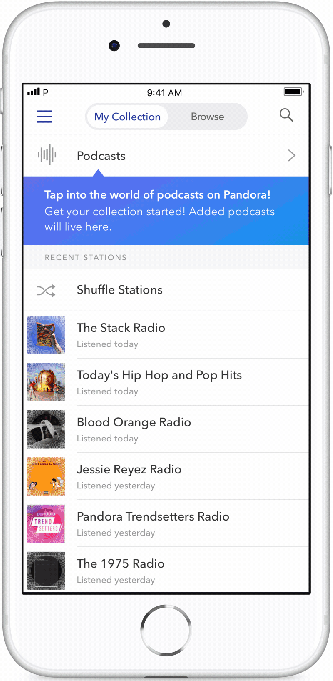
Pandora then combines this data with human curation to make its podcast recommendations.
These recommendations are live now in the Pandora app’s “Browse” section, under the banner “Recommended Podcasts For You.” Podcasts will also be discoverable throughout the app in the Now Playing screen, search bar, in the podcast backstage passes and in the episode backstage passes.
At launch, the app is aggregating more than 100,000 podcast episodes in genres like News, True Crime, Sports, Comedy, Music, Business, Technology, Entertainment, Kids, Health and Science, the company adds.
Podcasters can also now ask to be included in Pandora’s app by filling out a form here.
Longer-term, a better recommendation system for podcasts could help Pandora as it becomes more integrated with its acquirer SiriusXM. The deal will likely bring SiriusXM’s exclusive programming to Pandora’s subscribers, which would greatly increase the number of audio programs available on its service. Putting the right programs in front of the most interested customers could then drive more people to upgrade to a paid subscription, impacting Pandora’s bottom line.
Powered by WPeMatico
Duet Display is an app that lets you turn your iPad into a second Mac monitor. And the team behind it just released a major update that makes it much more efficient — it consumes less CPU resources and is now recognized as a true external display.
If you’ve used Duet Display over the past few years, you may have seen a change that made it worse, not better. At some point, Apple updated macOS and broke Duet Display’s method.
Duet Display had to use AirPlay as a fallback method. It made the app much less versatile as you were restricted to a handful of 16:9 resolutions with black bars.
But this is a thing of the past as Duet Display found a way to leverage GPU acceleration. It means that your iPad now appears as a display in macOS settings. It also should be more energy-efficient. In my experience, it’s now much closer to a normal external display. If you’re traveling and need a lot of screen real estate, it’s a good solution.
Luna Display has been able to do the same thing using a hardware dongle. Duet Display is now catching up with its competitor by releasing this update.
Version 2.0 is a free update. Make sure to download the latest version on your iPad and your Mac. For new users, Duet Display costs $10. You can optionally pay $20 or $25 per year for additional features, such as wireless connectivity and Apple Pencil support.
Update: Here’s what Duet Display has to say about Luna Display:
To be clear, it’s not catch up. We are faster, entirely in software & cost nearly 10 times less, so more like Luna is obsolete
— Duet Display (@duetdisplay) December 5, 2018
Powered by WPeMatico
Mobile intelligence and data firm App Annie is today releasing its 2019 predictions for the worldwide app economy, including its forecast around consumer spending, gaming, the subscription market and other highlights. Most notably, it expects the worldwide gross consumer spend in apps — meaning before the app stores take their own cut — to surpass $122 billion next year, which is double the size of the global box office market, for comparison’s sake.
According to the new forecast, the worldwide app store consumer spend will grow five times as fast as the overall global economy next year.
But the forecast also notes that “consumer spend” — which refers to the money consumers spend on apps and through in-app purchases — is only one metric to track the apps stores’ growth and revenue potential.
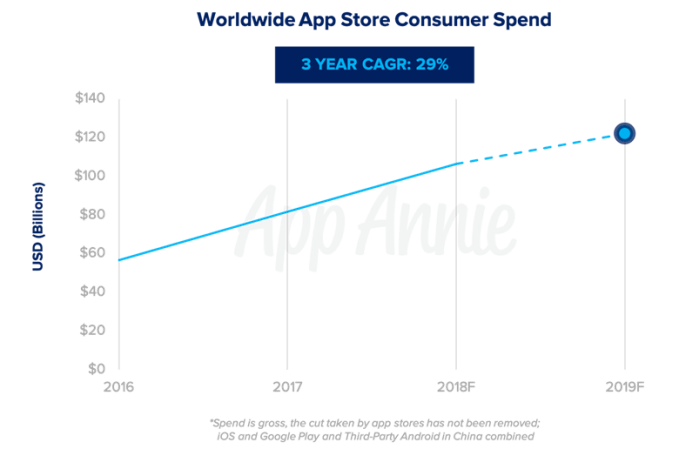
Mobile spending is also expected to continue growing for both in-app advertising and commerce — that is, the transactions that take place outside of the app stores in apps like Uber, Amazon and Starbucks, for example.
Specifically, mobile will account for 62 percent of global digital ad spend in 2019, representing $155 billion, up from 50 percent in 2017. In addition, 60 percent more mobile apps will monetize through in-app ads in 2019.
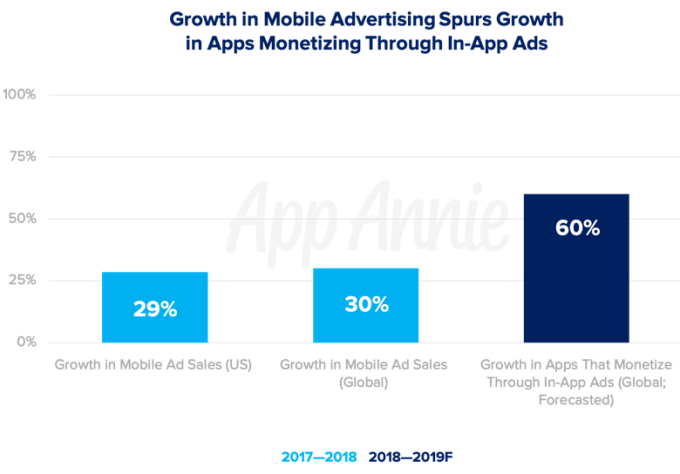
As in previous years, mobile gaming is contributing to the bulk of the growth in consumer spending, the report says.
Mobile gaming, which continues to be the fastest growing form of gaming, matured further this year with apps like Fortnite and PUBG, says App Annie . These games “drove multiplayer game mechanics that put them on par with real-time strategy and shooter games on PC/Mac and Consoles in a way that hadn’t been done before,” the firm said.
They also helped push forward a trend toward cross-platform gaming, and App Annie expects that to continue in 2019 with more games becoming less siloed.
However, the gaming market won’t just be growing because of experiences like PUBG and Fortnite. “Hyper-casual” games — that is, those with very simple gameplay — will also drive download growth in 2019.
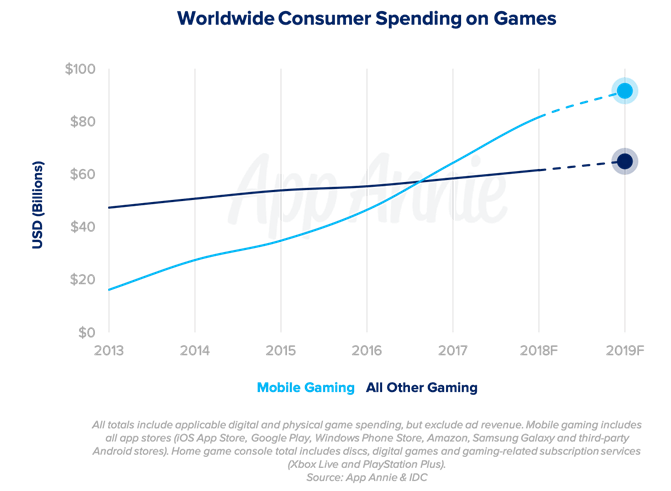
Over the course of the next year, consumer spend in mobile gaming will reach 60 percent market share across all major platforms, including PC, Mac, console, handheld and mobile.
China will remain a major contributor to overall app store consumer spend, including mobile gaming, but there may be a slight deceleration of their impact next year due to the game licensing freeze. In August, Bloomberg reported China’s regulators froze approval of game licenses amid a government shake-up. The freeze impacted the entire sector, from large players like internet giant Tencent to smaller developers.
If the freeze continues in 2019, App Annie believes Chinese firms will push toward international expansion and M&A activity could result.
App Annie is also predicting one breakout gaming hit for 2019: Niantic’s Harry Potter: Wizards Unite, which it believes will exceed $100 million in consumer spend in its first 30 days. Niantic’s Pokémon GO, by comparison, cleared $100 million in its first two weeks and became the fastest game to reach $1 billion in consumer spend.
But App Annie isn’t going so far as to predict Harry Potter will do better than Pokémon GO, which tapped into consumer nostalgia and was a first-to-market mainstream AR gaming title.
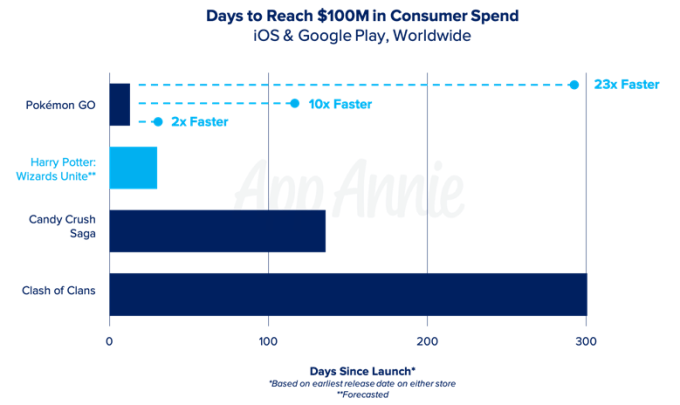
Another significant trend ahead for the new year is the growth in video streaming apps, fueled by in-app subscriptions.
Today, the average person consumers more than 7.5 hours of media per day, including watching, listening, reading or posting. Next year, 10 minutes of every hour will be spent consuming media across TV and internet will come from streaming video on mobile, the forecast says.
The total time in video streaming apps will increase 110 percent from 2016 to 2019, with consumer spend in entertainment apps up by 520 percent over that same period. Most of those revenues will come from the growth in in-app subscriptions.
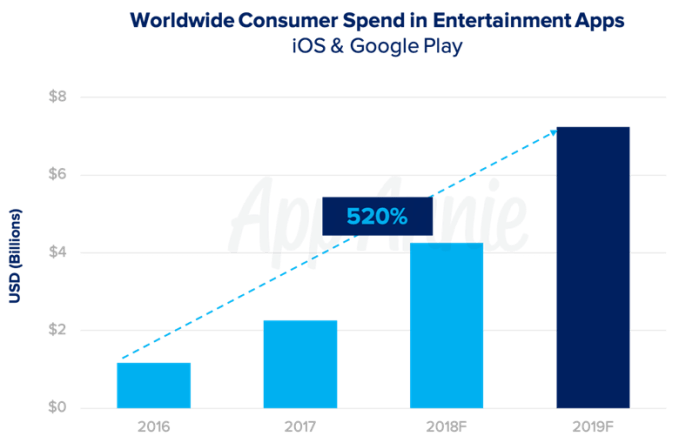
Much of the time consumers spend streaming will come from short-form video apps like YouTube, TikTok and social apps like Instagram and Snapchat.
YouTube alone accounts for 4 out of every 5 minutes spent in the top 10 video streaming apps, today. But 2019 will see many changes, including the launch of Disney’s streaming service, Disney+, for example.
App Annie’s full report, which details ad creatives and strategies as well, is available on its blog.
Powered by WPeMatico
Facebook will now freely allow developers to build competitors to its features upon its own platform. Today Facebook announced it will drop Platform Policy section 4.1, which stipulates “Add something unique to the community. Don’t replicate core functionality that Facebook already provides.”
Facebook had previously enforced that policy selectively to hurt competitors that had used its Find Friends or viral distribution features. Apps like Vine, Voxer, MessageMe, Phhhoto and more had been cut off from Facebook’s platform for too closely replicating its video, messaging or GIF creation tools. Find Friends is a vital API that lets users find their Facebook friends within other apps.
The move will significantly reduce the risk of building on the Facebook platform. It could also cast it in a better light in the eyes of regulators. Anyone seeking ways Facebook abuses its dominance will lose a talking point. And by creating a more fair and open platform where developers can build without fear of straying too close to Facebook’s history or road map, it could reinvigorate its developer ecosystem.

A Facebook spokesperson provided this statement to TechCrunch:
We built our developer platform years ago to pave the way for innovation in social apps and services. At that time we made the decision to restrict apps built on top of our platform that replicated our core functionality. These kind of restrictions are common across the tech industry with different platforms having their own variant including YouTube, Twitter, Snap and Apple. We regularly review our policies to ensure they are both protecting people’s data and enabling useful services to be built on our platform for the benefit of the Facebook community. As part of our ongoing review we have decided that we will remove this out of date policy so that our platform remains as open as possible. We think this is the right thing to do as platforms and technology develop and grow.
The change comes after Facebook locked down parts of its platform in April for privacy and security reasons in the wake of the Cambridge Analytica scandal. Diplomatically, Facebook said it didn’t expect the change to impact its standing with regulators but it’s open to answering their questions.
Earlier in April, I wrote a report on how Facebook used Policy 4.1 to attack competitors it saw gaining traction. The article, “Facebook shouldn’t block you from finding friends on competitors,” advocated for Facebook to make its social graph more portable and interoperable so users could decamp to competitors if they felt they weren’t treated right in order to coerce Facebook to act better.
The policy change will apply retroactively. Old apps that lost Find Friends or other functionality will be able to submit their app for review and, once approved, will regain access.
Friend lists still can’t be exported in a truly interoperable way. But at least now Facebook has enacted the spirit of that call to action. Developers won’t be in danger of losing access to that Find Friends Facebook API for treading in its path.
Below is an excerpt from our previous reporting on how Facebook has previously enforced Platform Policy 4.1 that before today’s change was used to hamper competitors:
Powered by WPeMatico
As the fight against climate change heats up, Cove.Tool is looking to help tackle carbon emissions one building at a time.
The Atlanta-based startup provides an automated big-data platform that helps architects, engineers and contractors identify the most cost-effective ways to make buildings compliant with energy efficiency requirements. After raising an initial round earlier this year, the company completed the final close of a $750,000 seed round. Since the initial announcement of the round earlier this month, Urban Us, the early-stage fund focused on companies transforming city life, has joined the syndicate comprised of Tech Square Labs and Knoll Ventures.

Cove.Tool software allows building designers and managers to plug in a variety of building conditions, energy options, and zoning specifications to get to the most cost-effective method of hitting building energy efficiency requirements (Cove.Tool Press Image / Cove.Tool / https://covetool.com).
In the US, the buildings we live and work in contribute more carbon emissions than any other sector. Governments across the country are now looking to improve energy consumption habits by implementing new building codes that set higher energy efficiency requirements for buildings.
However, figuring out the best ways to meet changing energy standards has become an increasingly difficult task for designers. For one, buildings are subject to differing federal, state and city codes that are all frequently updated and overlaid on one another. Therefore, the specific efficiency requirements for a building can be hard to understand, geographically unique and immensely variable from project to project.
Architects, engineers and contractors also have more options for managing energy consumption than ever before – equipped with tools like connected devices, real-time energy-management software and more-affordable renewable energy resources. And the effectiveness and cost of each resource are also impacted by variables distinct to each project and each location, such as local conditions, resource placement, and factors as specific as the amount of shade a building sees.
With designers and contractors facing countless resource combinations and weightings, Cove.Tool looks to make it easier to identify and implement the most cost-effective and efficient resource bundles that can be used to hit a building’s energy efficiency requirements.
Cove.Tool users begin by specifying a variety of project-specific inputs, which can include a vast amount of extremely granular detail around a building’s use, location, dimensions or otherwise. The software runs the inputs through a set of parametric energy models before spitting out the optimal resource combination under the set parameters.
For example, if a project is located on a site with heavy wind flow in a cold city, the platform might tell you to increase window size and spend on energy efficient wall installations, while reducing spending on HVAC systems. Along with its recommendations, Cove.Tool provides in-depth but fairly easy-to-understand graphical analyses that illustrate various aspects of a building’s energy performance under different scenarios and sensitivities.

Cove.Tool users can input granular project-specifics, such as shading from particular beams and facades, to get precise analyses around a building’s energy performance under different scenarios and sensitivities.
Traditionally, the design process for a building’s energy system can be quite painful for architecture and engineering firms.
An architect would send initial building designs to engineers, who then test out a variety of energy system scenarios over the course a few weeks. By the time the engineers are able to come back with an analysis, the architects have often made significant design changes, which then gets sent back to the engineers, forcing the energy plan to constantly be 1-to-3 months behind the rest of the building. This process can not only lead to less-efficient and more-expensive energy infrastructure, but the hectic back-and-forth can lead to longer project timelines, unexpected construction issues, delays and budget overruns.
Cove.Tool effectively looks to automate the process of “energy modeling.” The energy modeling looks to ease the pains of energy design in the same ways Building Information Modeling (BIM) has transformed architectural design and construction. Just as BIM creates predictive digital simulations that test all the design attributes of a project, energy modeling uses building specs, environmental conditions, and various other parameters to simulate a building’s energy efficiency, costs and footprint.
By using energy modeling, developers can optimize the design of the building’s energy system, adjust plans in real-time, and more effectively manage the construction of a building’s energy infrastructure. However, the expertise needed for energy modeling falls outside the comfort zones of many firms, who often have to outsource the task to expensive consultants.
The frustrations of energy system design and the complexities of energy modeling are ones the Cove.Tool team knows well. Patrick Chopson and Sandeep Ajuha, two of the company’s three co-founders, are former architects that worked as energy modeling consultants when they first began building out the Cove.Tool software.
After seeing their clients’ initial excitement over the ability to quickly analyze millions of combinations and instantly identify the ones that produce cost and energy savings, Patrick and Sandeep teamed up with CTO Daniel Chopson and focused full-time on building out a comprehensive automated solution that would allow firms to run energy modeling analysis without costly consultants, more quickly, and through an interface that would be easy enough for an architectural intern to use.
So far there seems to be serious demand for the product, with the company already boasting an impressive roster of customers that includes several of the country’s largest architecture firms, such as HGA, HKS and Cooper Carry. And the platform has delivered compelling results – for example, one residential developer was able to identify energy solutions that cost $2 million less than the building’s original model. With the funds from its seed round, Cove.Tool plans further enhance its sales effort while continuing to develop additional features for the platform.
The value proposition Cove.Tool hopes to offer is clear – the company wants to make it easier, faster and cheaper for firms to use innovative design processes that help identify the most cost-effective and energy-efficient solutions for their buildings, all while reducing the risks of redesign, delay and budget overruns.
Longer-term, the company hopes that it can help the building industry move towards more innovative project processes and more informed decision-making while making a serious dent in the fight against emissions.
“We want to change the way decisions are made. We want decisions to move away from being just intuition to become more data-driven.” The co-founders told TechCrunch.
“Ultimately we want to help stop climate change one building at a time. Stopping climate change is such a huge undertaking but if we can change the behavior of buildings it can be a bit easier. Architects and engineers are working hard but they need help and we need to change.”
Powered by WPeMatico
Uber Eats has effectively invented its own native ad unit. Uber confirmed to TechCrunch that a test quietly running in markets around India allows restaurants to bundle several food items together and sell them at a discounted price in exchange for promoted placement by Uber Eats in a featured section of local “Specials.” In some cases, restaurants foot the cost of the discount, while in others Uber pays for the discounts.
The Uber Specials feature demonstrates the massive leverage awarded to food delivery apps that aggregate restaurants. Users often come to Uber Eats and its competitors without a specific restaurant in mind. Uber can then point those customers to whichever food supplier it prefers. The suppliers in turn will increasingly compete for the favor of the aggregators — not just in terms of food quality, speed and review scores, but also in terms of discounts. The aggregators will win users if they offer the best deals; creating a network effect makes restaurants more keen to play ball.
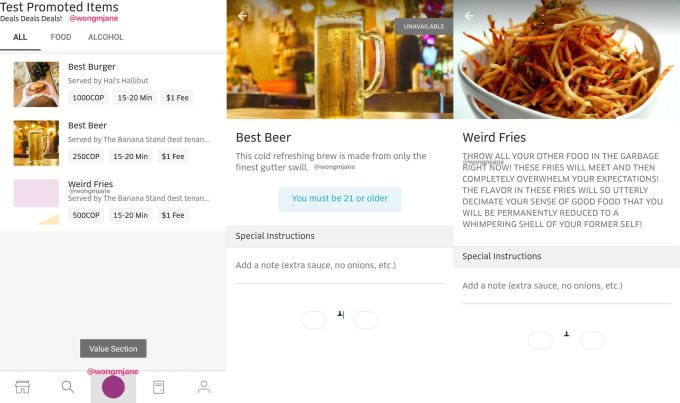
TechCrunch first learned of Uber’s ambitions in the space from a mock-up of the Promoted Items Value Section feature spotted in its app by mobile researcher and frequent TC tipster Jane Manchun Wong. The fictional food items included “Best Beer” that “is made from only the finest gutter swill” and “Weird Fries” that “will so utterly decimate your sense of good food that you will be permanently reduced to a whimpering shell of your former self!” This jokey text that seemingly was never meant for public viewing also noted that the fries are so good you should “throw all your other food in the garbage right now!” Uber assured us these weren’t real.
But what it did confirm is that the discounts for promoted placement test is live in India. “We’re always experimenting with ways to make it easier to find your favorite foods on Uber Eats,, according to a statement provided by an Uber spokesperson.
The feature allows restaurants to create a bundled meal at a certain price point, such as a chicken sandwich, french fries and a drink at a price that’s less than the sum of its parts. The company tells me the goal is to take the friction out of ordering by giving people pre-set meals at a better price prominently available in the app. Attracting more customers that have plenty of other options could offset the discount. Businesses could also use it to bundle high-margin items, like soft drinks, with meals, or to get rid of overstock.
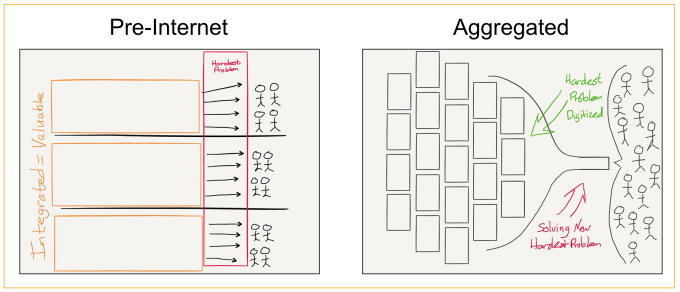
Ben Thompson’s aggregation theory describes how power accrues to aggregators that match supply with demand
It’s already common for restaurants to make “specials” out of food they have too much of. That butternut squash ravioli might only be featured because they can’t get rid of it. In that sense, you could think of Uber Specials as the inverse of surge pricing. When supply is too high, restaurants can offer discounts to gain more demand. It’s also not far off from Google Search’s keyword ads where business pay for more visibility.
Uber wouldn’t discuss whether it plans to bring the strategy to other markets, but it makes sense to assume it’s considering expansion. Done wrong, it could look a bit like Uber Eats is pressuring restaurants to surrender discounts if they want to be discoverable inside its app. If restaurants within Uber Eats get into heated competition to offer discounts, it could drive down their profits. But done right, Specials could look like a triple-win. Restaurants can offload surplus and bundle in high-margin items while scoring new customers from enhanced placement, customers get cheaper food options and Uber Eats becomes people’s go-to app for easy-to-order discounted meals.
Powered by WPeMatico
YouTube on Monday announced a significant change to its mobile app — it will now autoplay videos by default when users are browsing the app’s home page, aka the “Home” tab. Fortunately, the videos will not autoplay with the sound enabled, the company says. Instead, the feature is meant to give users a preview of the video while scrolling through the Home section, so they can better decide if it’s something they want to watch.
The feature, which YouTube calls “Autoplay on Home,” is enabled by default. However, the app will introduce settings that will allow users to control their experience. Users can opt to turn the feature off entirely, if they choose, or they can opt to have autoplay only enabled when they’re connected to a Wi-Fi network.
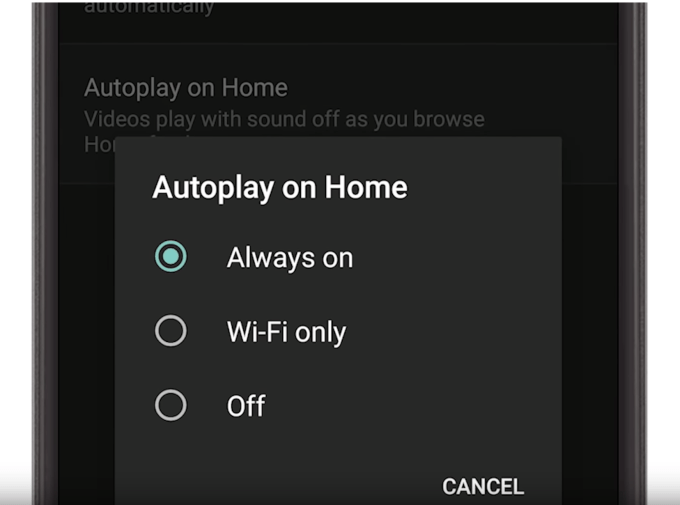
Autoplay for Home is not an entirely new feature. It’s actually been up-and-running for over half a year for YouTube Premium members on Android. Premium is YouTube’s subscription offering, which removes the ads from YouTube while also offering other perks like downloads for offline access to videos, background play and access to YouTube Music and YouTube Originals.
Starting this week, Autoplay on Home is rolling out beyond Premium subscribers to all those who use the YouTube app on iOS and Android. As with most launches across YouTube, it’s a staged rollout — meaning you may not see autoplay immediately. YouTube says it will take a few weeks for the rollout to complete.
The company notes it made the decision to expand autoplay because it increases users’ engagement time with videos.
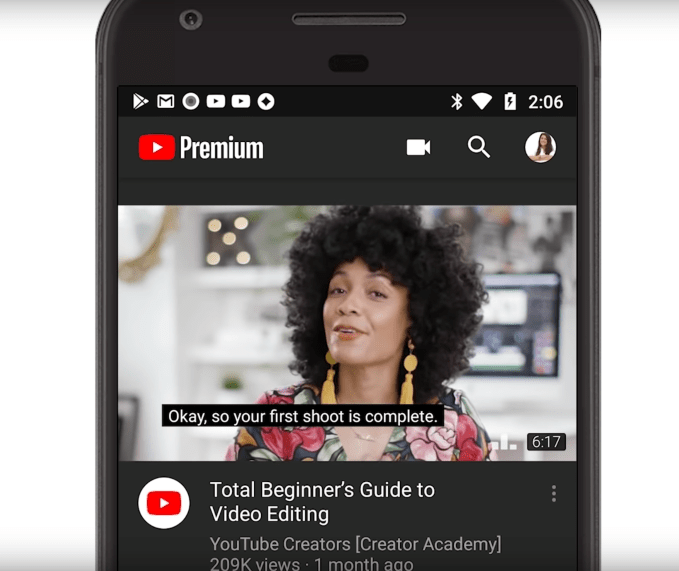
As YouTube explains in an announcement on its product forum (spotted first by Tubefilter): “previewing videos helps you make more informed decisions about whether you want to watch a video, leading to longer engagement with videos you choose to watch.”
The company also detailed its decision further in a YouTube Help video (embedded below) where it noted that autoplay’s launch doesn’t mean thumbnails are going away. Instead, YouTube will display the thumbnail first during a brief pause before the video begins to autoplay.
With the launch of autoplay, YouTube also noted that captions would become more important.
Today, the number of videos with captions enabled tops 2 billion, it said. The site offers a variety of options for captions, including automated captions (which aren’t always perfect), creator-uploaded captions and crowdsourced community captions.
It’s not surprising to see YouTube adopt autoplay, given that rivals, including Facebook, Instagram, Twitter and others already do the same, as do some streaming services, like Netflix.
User reaction, following YouTube’s announcement on Twitter, has been mixed. Some people said they were looking forward to the feature, while others lamented that it’s now just another setting they have to turn off.
Powered by WPeMatico
Facebook hasn’t had a hit show yet for its long-form video hub Watch, so it’s got a new plan: digging up some deceased cult favorites from television. First up, Facebook is making all episodes of Joss Whedon’s Buffy The Vampire Slayer, Angel, and Firefly free on Facebook Watch. There’ll be simultaneous viewing Watch Parties where fans can live-comment together for Buffy at 3 pm PT today, Angel tomorrow at 12 pm PT and Firefly on Sunday at 12 pm PT. Facebook recruited Buffy star Sarah Michelle Gellar to promote the launch.
These shows aren’t original, and they’re far from exclusive, as they’re included in a Hulu subscription and are available to rent or buy on other platforms. But at least they’re not run-of-the-mill web content. With Facebook’s remake of MTV’s Real World not arriving until Spring 2019, these sci-fi and horror shows are the most high-profile programs available on the free ad-supported streaming service. The hope is that fans of these shows will come get a taste of Watch, and then explore the rest of its programming.
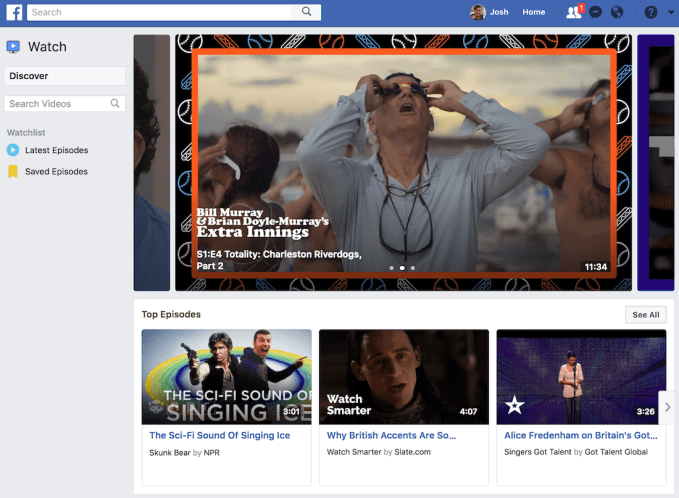
However, Facebook downplayed this as a change is overarching strategy when I asked if it would be licensing more old TV shows. Instead, it’s trying to build a well-rounded mix of content. A Facebook spokesperson provided this statement:
No – this doesn’t reflect a strategy shift. We’re focused on bringing content to Watch that people want to discuss and create a community around — whether that’s live sports like UEFA Champions League in Latin America, compelling shows like Sorry For Your Loss, Queen America and Sacred Lies, or even nostalgia content like Real World reboot we’re bringing to Watch next year. Buffy, Firefly and Angel are pop culture favorites with dedicated fan bases, and we’re excited for the opportunity to bring these shows back in a way that enables fans to watch and discuss together on the same platform.
There’s no guarantee Whedon fans will flock to Watch in droves. [TechCrunch owner] Verizon tried the same thing, bringing Veronica Mars and Babylon 5 to its Go90 streaming service. That failed to move the needle and Go90 eventually shut down. Meanwhile, Watch Party’s simultaneous viewing hasn’t blossomed into a phenomenon, but perhaps bringing the feature to Messenger (which TechCrunch reports Facebook is internally testing) could more naturally spur these social consumption experiences.

Watch has made some progress since its lackluster August 2017 debut. Indeed, 50 million people now spend at least 1 minute per month with Watch. For comparison, more than 18 Snapchat Shows have over 10 million unique viewers per month. Facebook Watch users spend 5X longer watching than on clips discovered on News Feed videos. But Facebook Watch really needs to pour the cash in necessary to secure a tent-pole series — its Game of Thrones or House of Cards. That might mesh well with its new strategy of conceding the younger audience that’s abandoning Facebook in favor of targeting older users, CNBC reported.
With so much free video content floating around and plenty of people already subscribing to Netflix, Hulu and/or HBO, it’s been tough for Watch to gain traction when it’s so far outside the understood Facebook use case. Laying a bed of diverse content is a good baby step, but it needs something truly must-see if it’s going to wedge its way into our viewing habits.
Powered by WPeMatico
Black Friday wasn’t just a boon for e-commerce retailers, it helped the mobile app stores break new records, too. According to a new report from Sensor Tower, the combined consumer spending across the U.S. Apple App Store and Google Play on Black Friday 2018 reached $75.9 million — a record for the most ever spent in a single day on both stores.
The App Store accounted for most of that figure, however, with U.S. consumers spending a record $52 million on Black Friday. That’s a 31.6 percent increase in spending over last year’s shopping event, when consumers then spent $39.5 million.
It’s also notably higher than Christmas 2017, when spending reached $39.8 million — typically a strong day for app purchases and in-app sales, as consumers unwrap new iPhones.
The App Store’s $52 million was more than double the $23.9 million spent on Google Play during the same time.

Sensor Tower attributes the increased spending to a variety of factors, largely driven by mobile gaming. Game makers this year got in on the Black Friday action by offering players discounts on in-app purchases and other special bundles.
On the U.S. App Store, mobile gaming accounted for 68 percent of Black Friday spending, with consumers spending $35.4 million on games. That’s a 63 percent increase from the week prior, the report notes.
Other categories saw a boost, too, including Food & Drink and Sports — both reflective of the leisure time consumers had over the holidays. Food & Drink grew 34 percent while Sports grew 49 percent, Sensor Tower found, with top apps like NYT Cooking and ESPN: Live Sports and Scores benefiting from the surge.
Though the Black Friday shopping holiday is heavily associated with the U.S. because of its ties to Thanksgiving, the sales event is making its way around the world, too.
On the mobile app stores, that meant worldwide consumer spending saw a jump this year, as well.
The firm found that $117.3 million was spent by App Store users outside the United States on Black Friday, bringing the global total to $169.3 million, up 18.4 percent from 2017. The spending outside the U.S. was up 13.9 percent year-over-year, but that’s lower than the U.S.’s year-over-year growth of 31.6 percent between Black Friday 2017 and Black Friday 2018.
Also of note: While Amazon had its biggest day ever on Cyber Monday 2018, Cyber Monday didn’t perform as well on the app stores. In the U.S., app revenue was up about 20 percent versus the previous Cyber Monday, to reach an estimated $37 million.
Powered by WPeMatico